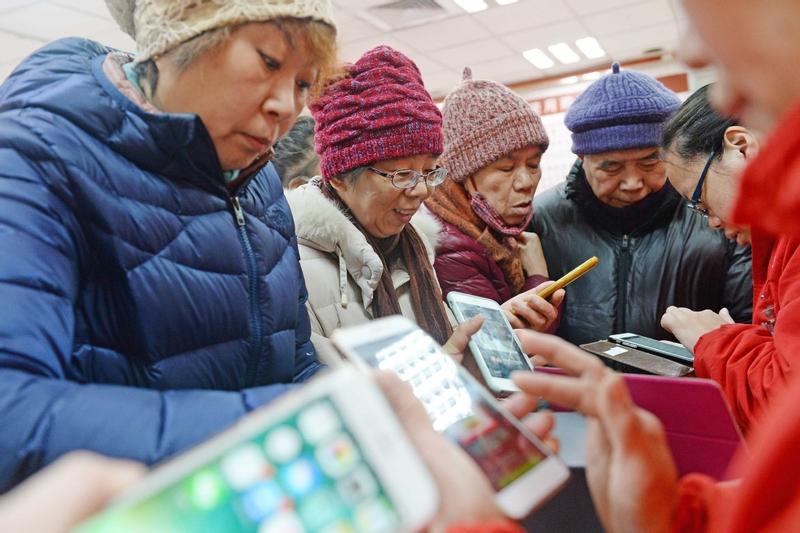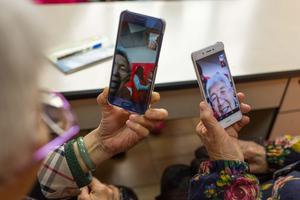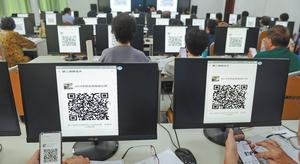Lower threshold will help the elderly connect to information age, writes Li Lei.
 Seniors apply for a free box of eggs through Taobao, an online shopping platform, in Shanghai. The activity was initiated by Taobao and local supermarkets to attract the elderly to engage in online shopping. (NIU JING / FOR CHINA DAILY)
Seniors apply for a free box of eggs through Taobao, an online shopping platform, in Shanghai. The activity was initiated by Taobao and local supermarkets to attract the elderly to engage in online shopping. (NIU JING / FOR CHINA DAILY)
Green, yellow, red. Traffic lights? Changing colors of foliage in the fall? Well, they signify something more.
As the monthslong lockdown to contain the novel coronavirus eased in Harbin, Heilongjiang province, Wen Caili, 60, ventured out of her home to get a taste of freedom.
In the digital age, we need to make appropriate use of information and communications technology to lower the threshold so that older people can connect with the information age at their current cognitive level
Yang Yifan, deputy head of the National Interdisciplinary Institute on Aging of the South-west Jiaotong University
But the retired kindergarten administrator, who lives with her daughter, son-and grandson-in-law in the northeastern city, soon found herself bound by new shackles.
"Health checkpoints" have come up across Harbin. And the personnel manning one such checkpoint demanded that Wen show her "health code"-a digital pass that comes in green, yellow or red.
Green allows people to travel almost unimpeded across the city. Yellow and red both bar visits to shopping malls, supermarkets and other public spaces, and limit the use of public transportation. Yellow requires a quarantine period of seven days and red, 14 days.
The health code is generated by a smartphone app based on the user's recent travel history and other data.
First adopted by authorities in Hangzhou, Zhejiang province, which hosts the headquarters of tech giant Alibaba, in February, the health code-based virus control measures have since been extended nationwide.
But despite being embraced by tech-savvy millennials, the code has confused people like Wen even as life across the country cautiously returns to normal.
Wen struggled to make sense of how her daughter, on her behalf, installed the app by submitting a host of her personal data.
And even with her smartphone in hand, Wen couldn't figure out how to scan the square-shaped Quick Response code-a mix of black and white pixels-to register at a health checkpoint.
The scanning registration process-usually required by restaurants and shopping malls-gives the digital footprint of the user which can be used to trace potential virus carriers in case of an outbreak.
According to a survey released last month by People Think Tank, which is affiliated to People's Daily, less than 1 percent of the nearly 6,000 respondents across the country said they did not have a health code, and more than 96 percent said the health code was required when visiting public places and offices in the cities or towns they live in.
 Seniors learn how to make video calls on mobile phones at a community in Taiyuan, Shanxi province. (XIAO BEI / FOR CHINA DAILY)
Seniors learn how to make video calls on mobile phones at a community in Taiyuan, Shanxi province. (XIAO BEI / FOR CHINA DAILY)
Digital divide
Although she has been using a smartphone for six years, Wen's online reach has been limited largely to games, short videos and news disseminating apps.
For any cyber-based exploration requiring online payments or typing in home address-such as online shopping or using food delivery or car-hailing services-she seeks the help of family members.
"I cannot imagine living alone. I may not be able to even leave the neighborhood without my daughter's help," Wen said.
Wen completed high school in Hegang, a city about five hours' drive from Harbin. Which makes her better educated than many of her peers given that relatively few youths completed high school in the 1970s in China.
Wen is not alone from her generation to be confused with digital technology. A video clip widely shared online in late August showed a driver in Harbin refusing to start the bus full of passengers after a gray-haired man could not show his health code because he didn't own any electronic devices.
The driver called the police as the senior citizen refused to get down from the bus despite being told about the no-code-no-ride policy, with some young passengers appearing visibly irritated by the disruption.
The senior citizen was eventually driven to his destination by police.
The video drew a lot of criticism online, with many saying the policy discriminates against the digitally illiterate-the elderly and children. Others accused the irritated bus passengers of being cold-blooded.
The video also prompted the municipal authorities to consider reforms.
Netizens suggested the health data be attached to cards for senior citizens, which governments issue to people aged 60 or above. The magnetic card with the holder's real name is expected to help reduce senior citizens' reliance on electronic devices.
In fact, the Harbin municipal government and authorities in some other cities introduced health code substitutes in March.
The local authorities said tech-savvy family members could help non-smartphone users, such as the elderly and children, apply to get them installed on their mobile handsets and print out screenshots of the code. But the paper version is valid for just a week.
The efforts of the local authorities notwithstanding, the bus episode highlighted the digital divide that has widened since the outbreak of the epidemic, which prompted government officials to shift many of the essential services from brick-and-mortar offices to virtual platforms.
Hu Qiao, a retiree based in Chengdu, Sichuan province, said the digitalization drive in local hospitals-which accelerated after the outbreak to help keep people away from suspected virus carriers-has increased her dependency on her daughter Shangguan Zirui for tasks ranging from making online reservations for visiting a doctor to paying bills.
Motivated by her mother's dilemma, Shangguan, 33, started a project in Chengdu in July to make so-called active seniors aged between 55 and 70 digitally literate, because they require basic digital knowledge for their social mobility.
She said older adults are marginalized in this era of health code, digitalized hospital registration system and car-hailing services.
"Many were successful in their respective fields as professionals, but after retirement they have been labeled 'old people', which is a bit of ageism," she said.
Officially, people aged 60 or above are classified as senior citizens, which means the youngest in the age group were born in the late 1950s and could access the internet only after their mid-30s. Smartphones and apps are relatively recent developments, so they struggle to use high-tech devices and apps.
Data from the China Internet Network Information Center show that internet users age 60 or above make up just 6.7 percent of the country's 904 million netizens, which means underrepresentation given that senior citizens account for 18.1 percent of the total population. China had about 253 million people aged 60 or above by the end of last year, according to the National Bureau of Statistics.
 Seniors learn about QR codes at a university for the elderly in Fuzhou, Fujian province. (ZHANG WENLIANG / FOR CHINA DAILY)
Seniors learn about QR codes at a university for the elderly in Fuzhou, Fujian province. (ZHANG WENLIANG / FOR CHINA DAILY)
Employability
The digital divide has caused inconveniences, especially to the elderly.
Bank tellers are generally reluctant to deal with small-sum transactions, compelling the elderly to use ATMs that many of them struggle to comprehend. Self-service convenient stores have mushroomed to slash operation costs, but they don't have any space for older people who are not comfortable with online payment.
The digital divide can also reduce older worker's employability as many things have gone virtual to reduce physical visits to government offices.
Peng Ziying knows the impact of the digital divide on the elderly.
She works in Beijing but often provides digital guidance via video chats on messaging app WeChat for her father, a truck driver in Zhaoqing, Guangdong province, who drives regularly to the provincial capital of Guangzhou.
As Guangzhou limits the number of out-of-town vehicles entering the city's urban areas, Peng's father struggles to find out the date, area and time slots for entering the city so as to avoid penalties.
"I am busy myself, and I can help him only after work," Peng said.
The disadvantages are also felt by older migrant workers, whose limited digital literacy prevents them from claiming a slice of the country's fast-expanding gig economy as designated drivers, food delivery-persons and couriers.
Instead, they have to opt for physically challenging work at construction sites.
Statistics from the Beijing Municipal Commission of Housing and Rural-Urban Development show the average age of construction workers in the city was 43.1 in 2017, almost 10 years older than in 2007.
And by the end of 2017, workers in the 40-to-60 age group accounted for 60 percent of the capital's construction workforce compared with 35 percent in the 20-to-40 age group.
Catering to seniors
Shangguan said they have been developing courses to help senior citizens learn how to maximize the use of their handsets and gather some experience of surfing the internet to shake off solitude.
The courses cover how to use a calculator, calendar and other in-built functions on handsets, and how to adjust the font size, which is a crucial skill for the elderly.
"Many of the software developed (by big companies) target young people, and usually feature minimalist design, small characters and multiple content sections, which are very unfriendly for elderly users," she said, adding that tutorials and guides are usually absent.
As such, she suggested that developers consider the needs of senior citizens and develop tailored versions for them, or allow them to quickly switch to "elderly mode".
Yang Yifan, deputy head of the National Interdisciplinary Institute on Aging affiliated with the Southwest Jiaotong University in Chengdu, said China cannot afford to let the elderly lag behind the rest of the population in the digital era as there will be huge price to pay.
"In the digital age, we need to make appropriate use of information and communications technology to lower the threshold so that older people can connect with the information age at their current cognitive level," he said.
Contact the writer at lilei@chinadaily.com.cn


